Research Area B - Publications 2012
26-Dec-2012
PNAS, online article
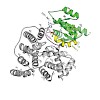
Rab GTPases, key regulators of vesicular transport, hydrolyze GTP very slowly unless assisted by Rab GTPase-activating proteins (RabGAPs). Dysfunction of RabGAPs is involved in many diseases. By combining X-ray structure analysis and time-resolved FTIR spectroscopy we reveal here the detailed molecular reaction mechanism of a complex between human Rab and RabGAP ...
26-Dec-2012
PNAS, online article
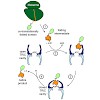
The eukaryotic chaperonin, TRiC/CCT (TRiC, TCP-1 ring complex; CCT, chaperonin containing TCP-1), uses a built-in lid to mediate protein folding in an enclosed central cavity. Recent structural data suggest an effective size limit for the TRiC folding chamber of ∼70 kDa, but numerous chaperonin substrates are substantially larger. Using artificial fusion ...
11-Dec-2012
PNAS, online article

Small heat shock proteins (sHsps) are molecular chaperones that prevent the aggregation of nonnative proteins. The sHsps investigated to date mostly form large, oligomeric complexes. The typical bacterial scenario seemed to be a two-component sHsps system of two homologous sHsps, such as the Escherichia coli sHsps IbpA and IbpB. With a view to expand our ...
Promiscuous behaviour of archaeal ribosomal proteins: Implications for eukaryotic ribosome evolution
06-Dec-2012
Nucl. Acids Res., online article
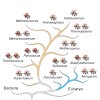
In all living cells, protein synthesis occurs on ribonucleoprotein particles called ribosomes. Molecular models have been reported for complete bacterial 70S and eukaryotic 80S ribosomes; however, only molecular models of large 50S subunits have been reported for archaea. Here, we present a complete molecular model for the Pyrococcus furiosus 70S ribosome based ...
21-Nov-2012
Planta, online article
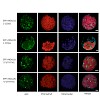
Members of the Alb3/Oxa1/YidC protein family function as insertases in chloroplasts, mitochondria, and bacteria. Due to independent gene duplications, all organisms possess two isoforms, Oxa1 and Oxa2 except gram-negative bacteria, which encode only for one YidC-like protein. The genome of Arabidopsis thaliana however, encodes for eight different isoforms. The ...
12-Oct-2012
Journal of Biological Chemistry, online article
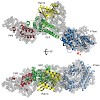
After the pathogenic bacterium Legionella pneumophila is phagocytosed, it injects more than 250 different proteins into the cytoplasm of host cells to evade lysosomal digestion and to replicate inside the host cell. Among these secreted proteins is the protein DrrA/SidM, which has been shown to modify Rab1b, a main regulator of vesicular trafficking in eukaryotic ...
06-Oct-2012
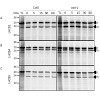
Chloroplast-located proteins which are encoded by the nuclear genome have to be imported from the cytosol into the organelle in a post-translational manner. Among these nuclear-encoded chloroplast proteins are the light-harvesting chlorophyll a/b-binding proteins (LHCPs). After translation in the cytosol, precursor proteins of LHCPs are imported via the TOC/TIC ...
02-Oct-2012
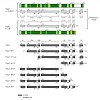
The vesicle-inducing protein in plastids 1 (Vipp1) is an essential component for thylakoid biogenesis in cyanobacteria and chloroplasts. Vipp1 proteins share significant structural similarity with their evolutionary ancestor PspA (bacterial phage shock protein A), namely a predominantly α-helical structure, the formation of oligomeric high molecular weight ...
03-Sep-2012
The Plant Cell, online article
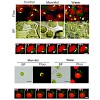
VESICLE-INDUCING PROTEIN IN PLASTIDS1 (VIPP1), proposed to play a role in thylakoid biogenesis, is conserved in photosynthetic organisms and is closely related to Phage Shock Protein A (PspA), which is involved in plasma membrane integrity in Escherichia coli. This study showed that chloroplasts/plastids in Arabidopsis thaliana vipp1 knockdown and knockout ...
16-Aug-2012
Journal of Cell Science, online article
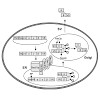
Chaperone-assisted sorting of post-translationally imported proteins is a general mechanism among all eukaryotic organisms. Interaction of some preproteins with the organellar membranes is mediated by chaperones, which are recognised by membrane-bound tetratricopeptide repeat (TPR) domain containing proteins. We have characterised AtTPR7 as an endoplasmic ...
10-Apr-2012
PNAS, online article
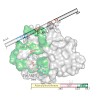
Intracellular vesicular trafficking is regulated by approximately 60 members of the Rab subfamily of small Ras-like GDP/GTP binding proteins. Rab proteins cycle between inactive and active states as well as between cytosolic and membrane bound forms. Membrane extraction/delivery and cytosolic distribution of Rabs is mediated by interaction with the protein GDP ...
16-Mar-2012
The Plant Journal, online article

Arabidopsis thaliana contains two photosynthetically competent chloroplast-targeted ferredoxin-NADP+ oxidoreductase (FNR) isoforms that are largely redundant in their function. Nevertheless, the FNR isoforms also display distinct molecular phenotypes, as only the FNR1 is able to directly bind to the thylakoid membrane. We report the consequences of depletion of ...
15-Mar-2012
Biochimica et Biophysica Acta, online article
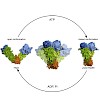
Hsp90 is a dimeric molecular chaperone required for the activation and stabilization of numerous client proteins many of which are involved in essential cellular processes like signal transduction pathways. This activation process is regulated by ATP-induced large conformational changes, co-chaperones and posttranslational modifications. For some co-chaperones, a ...
24-Feb-2012
Molecular Cell, online article
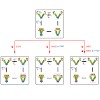
Hsp90 is an essential molecular chaperone in the eukaryotic cytosol. Its function is modulated by cochaperones and posttranslational modifications. Importantly, the phosphatase Ppt1 is a dedicated regulator of the Hsp90 chaperone system. Little is known about Ppt1-dependent phosphorylation sites and how these affect Hsp90 activity. Here, we identified the major ...
24-Feb-2012
The Journal of Biological Chemistry, online article
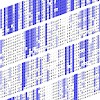
Hypochlorite is a powerful oxidant produced by neutrophils to kill invading microorganisms. Despite this important physiological role of HOCl in fighting bacterial infections, no hypochlorite-specific stress response has been identified yet. Here, we identified a hypochlorite-responsive transcription factor, YjiE, which is conserved in proteobacteria and ...
17-Feb-2012
Physiologia Plantarum, online article
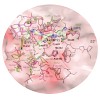
Programmed cell death (PCD) in plants is a prerequisite for development as well as seed and fruit production. It also plays a significant role in pathogen defense. A unique group of papain-type cysteine endopeptidases, characterized by a C-terminal endoplasmic reticulum (ER) retention signal (KDEL CysEP), is involved in plant PCD. Genes for these endopeptidases ...
03-Feb-2012
The EMBO Journal, 2012, doi:10.1038/emboj.2012.16, 31, 1774 - 1784 published on 03.02.2012
The EMBO Journal, online article
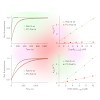
The Legionella pneumophila protein AnkX that is injected into infected cells by a Type IV secretion system transfers a phosphocholine group from CDP-choline to a serine in the Rab1 and Rab35 GTPase Switch II regions. We show here that the consequences of phosphocholination on the interaction of Rab1/Rab35 with various partner proteins are quite distinct. ...
25-Jan-2012
Journal of Experimental Botany, 2012, doi: 10.1093/jxb/err377, Vol. 63, No. 4, pp. 1713–1723, published on 25.01.2012
Journal of Experimental Botany, online article
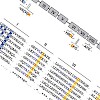
In addition to redox regulation, protein phosphorylation has gained increasing importance as a regulatory principle in chloroplasts in recent years. However, only very few chloroplast-localized protein kinases have been identified to date. Protein phosphorylation regulates important chloroplast processes such as photosynthesis or transcription. In order to better ...
08-Jan-2012
Protoplasma, online article
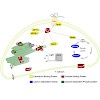
More than 70 years of studies have indicated that chloroplasts contain a significant amount of calcium, are a potential storage compartment for this ion, and might themselves be prone to calcium regulation. Many of these studies have been performed on the photosynthetic light reaction as well as CO2 fixation via the Calvin–Benson–Bassham cycle, and they showed ...
06-Jan-2012
The EMBO Journal, online article

Sti1/Hop is a modular protein required for the transfer of client proteins from the Hsp70 to the Hsp90 chaperone system in eukaryotes. It binds Hsp70 and Hsp90 simultaneously via TPR (tetratricopeptide repeat) domains. Sti1/Hop contains three TPR domains (TPR1, TPR2A and TPR2B) and two domains of unknown structure (DP1 and DP2). We show that TPR2A is the high ...
02-Jan-2012
Journal of Experimental Botany, online article
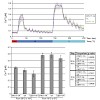
Calcium has long been acknowledged as one of the most important signalling components in plants. Many abiotic and biotic stimuli are transduced into a cellular response by temporal and spatial changes in cellular calcium concentration and the calcium-sensitive protein aequorin has been exploited as a genetically encoded calcium indicator for the measurement of ...










